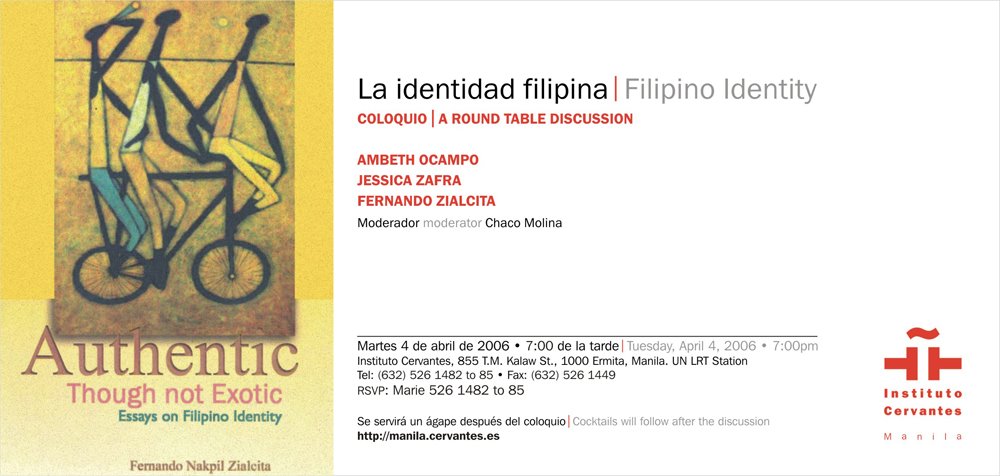
Managed to attend a roundtable discussion on Filipino Identity at the Instituto Cervantes. I had to squeeze it in between footspa and paper checking and literally had to squeeze through shelves and a huge crowd. There was no round table and there were lots of people and they had to bring in more chairs to accommodate everyone.
I was also lucky enough to arrive at the venue on time. The footspa took longer than expected and I had to leave before I could have a pedi, but I managed to get a cab in under 20 minutes and sailed through Manila, turned right at Quirino Avenue, rounded the corner to Plaza Dilao, another right at UN Avenue, right turn to Taft and another right turn to Kalaw. All this in ten minutes, yey! (And yes, I realize this makes me sound like a ditz and an airhead, but anyway.)
The anthropologist Fernando Zialcita presented his book "Authentic Although Not Exotic," which was actually a collection of essays on Filipino Identity. The flyer advertised "the historian Ambeth Ocampo" as part of the panel, but in the end, the participants included Zialcita, Isagani Cruz and "the journalist Jessica Zafra," who came "underdressed" in a Darna t-shirt.
The panel was to address the huge question: What makes us Filipino? There's also the question of culture, of the tangible things that somehow make up our sense of selves. He clarified certain myths, like that of the Barong Tagalog, and of how in that huge conference in the 90s (was it the APEC conference?), there was this photo op wherein all the Asian leaders wore a barong and the Bangkok Post said it was a bad signifier, as the barong was "a slave shirt." This "barong-is-a-slave-shirt" myth was somehow popular as some "natives" were asked about why the fiber used for the barong was translucent, these said locals replied, "So they can check if you have a weapon hidden underneath. They also claimed that there was a law passed by the cortes in Spain that the indios not only had to be "x-rayed" for concealed weapons, but they also had to wear their shirts untucked, which was like an insult in those times. Zialcita disproved this notion, saying that Asians--like the Chinese and Indian people, tended to wear their shirts loose and untucked. He also added that the piña cloth was actually an innovation. Pineapples were imported from Mexico and the Pinoys thought, hey, we can turn this into really nice fiber. So the barong as we know it is really not Spanish in origin, but a mixture of ideas welded into one.
Which leads us to the next point: Pinoy culture is not handed down from the Spanish, and it's also not the "tribal" thing that some people insist we go back to. Pinoy culture is actually mestiso culture. (I hope I got this right.) A lot of people think that when you say "mestiso," it means "half-breed," as in half-Spanish, half-indio, or half-Chinese, or half-whatever. (We're not even bringing in that "half-Filipino, half-Filipina" definition. Hehe.) Which in turn makes people think that what we have is actually a "bastardized" culture, and hence we shouldn't be proud of it, or let's go back to that "pure" culture we had before the Spanish came.
Zialcita again points out that there no such thing as pure anymore. Mestiso actually means "mixed" or "from different origins." A fusion, really. So there's no point in trying to eradicate the culture that we know now, the dominant "Tagalog low land Catholic" way of living, because what the others are yearning for, that "pure" pre-Spanish, alibata-writing, and datu-headed, near-river-dwelling way of living is now lost. You can't efface 300 years.
This is where my Charlie Kaufman theory of understanding culture comes in. See, the people who want to revert to the nativist claim, the pure pre-Spanish way of living are like the people who go to Lacuna Inc and have their memories erased. But I don't think it's going to be effective. What happened is already indelible. We will still cook adobo with vinegar and soy sauce, nothing like the Latinate adobado. I don't think people will want to revert to the alibata. While it might look cool as a henna tattoo on your arm, try using it on all your documents or have the street names and everything converted to it. It'll be like effacing your entire life and relearning it, and then discover that what you just wrote in alibata script is "D2 na me."
More on this when I have time, after more checking, laundry drying and trying to catch my ride to the highlands. And yeah, muchos gracias to saturatedtextmachine for twisting my arm to go the lecture.
No comments:
Post a Comment